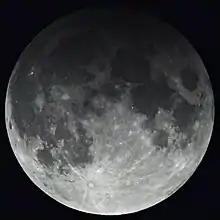| Total eclipse | |||||||||||||||||
| Date | 6 September 1979 | ||||||||||||||||
|---|---|---|---|---|---|---|---|---|---|---|---|---|---|---|---|---|---|
| Gamma | −0.43050 | ||||||||||||||||
| Magnitude | 1.09358 | ||||||||||||||||
| Saros cycle | 137 (25 of 80) | ||||||||||||||||
| Totality | 44 minutes, 24.7 seconds | ||||||||||||||||
| Partiality | 191 minutes, 54.2 seconds | ||||||||||||||||
| Penumbral | 305 minutes, 15.4 seconds | ||||||||||||||||
| |||||||||||||||||
A total lunar eclipse took place on Thursday, September 6, 1979, the second of two lunar eclipses in 1979. A shallow total eclipse saw the Moon in relative darkness for 44 minutes and 24.7 seconds. The Moon was 9.358% of its diameter into the Earth's umbral shadow, and should have been significantly darkened. The partial eclipse lasted for 3 hours, 11 minutes and 54.1 seconds in total.[1]
This event followed the annular solar eclipse of August 22, 1979.
Visibility
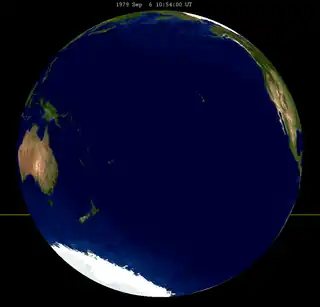
Related lunar eclipses
Eclipses in 1979
- A total solar eclipse on Monday, 26 February 1979.
- A partial lunar eclipse on Tuesday, 13 March 1979.
- An annular solar eclipse on Wednesday, 22 August 1979.
- A total lunar eclipse on Thursday, 6 September 1979.
Lunar year series
| Lunar eclipse series sets from 1977–1980 | ||||||||
|---|---|---|---|---|---|---|---|---|
| Ascending node | Descending node | |||||||
| Saros | Date Viewing |
Type Chart |
Gamma | Saros | Date Viewing |
Type Chart |
Gamma | |
| 112 | 1977 Apr 04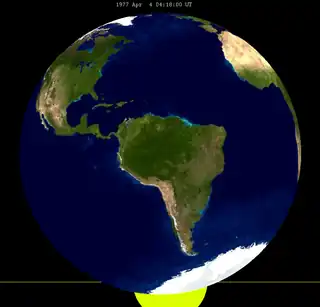 |
Partial |
−0.91483 | 117 | 1977 Sep 27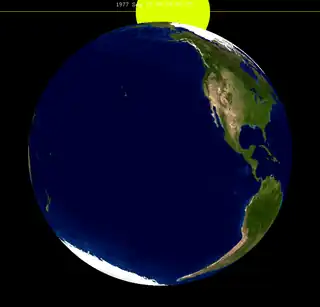 |
Penumbral |
1.07682 | |
| 122 | 1978 Mar 24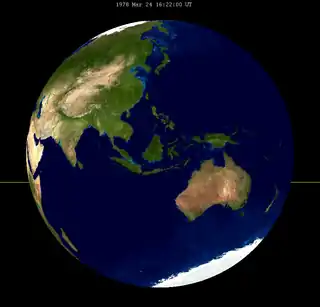 |
Total |
−0.21402 | 127 | 1978 Sep 16 |
Total |
0.29510 | |
| 132 | 1979 Mar 13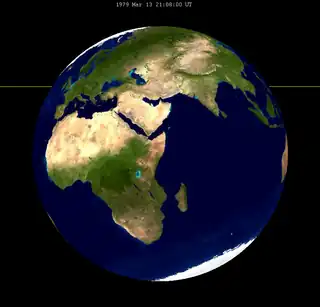 |
Partial |
0.52537 | 137 | 1979 Sep 06 |
Total |
−0.43050 | |
| 142 | 1980 Mar 01 |
Penumbral |
1.22701 | 147 | 1980 Aug 26 |
Penumbral |
−1.16082 | |
| Last set | 1976 May 13 | Last set | 1976 Nov 06 | |||||
| Next set | 1981 Jan 20 | Next set | 1980 Jul 27 | |||||
Saros series
It is part of Saros series 137.
Half-Saros cycle
A lunar eclipse will be preceded and followed by solar eclipses by 9 years and 5.5 days (a half saros).[2] This lunar eclipse is related to two annular solar eclipses of Solar Saros 144.
| August 31, 1970 | September 11, 1988 |
|---|---|
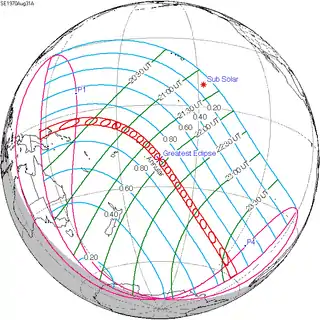 |
 |
See also
Notes
- ↑ Hermit Eclipse: Saros cycle 137
- ↑ Mathematical Astronomy Morsels, Jean Meeus, p.110, Chapter 18, The half-saros
External links
- 1979 Sep 06 chart Eclipse Predictions by Fred Espenak, NASA/GSFC
- September 6, 1979, a Lunar Eclipse
This article is issued from Wikipedia. The text is licensed under Creative Commons - Attribution - Sharealike. Additional terms may apply for the media files.
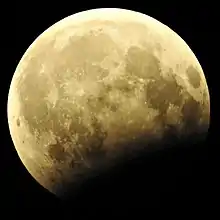
_(cropped).jpg.webp)
